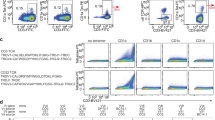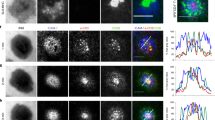Abstract
It is unclear if the interaction between CD8 and the T cell receptor (TCR)–CD3 complex is constitutive or antigen induced. Here, fluorescence resonance energy transfer microscopy between fluorescent chimeras of CD3ζ and CD8β showed that this interaction was induced by antigen recognition in the immunological synapse. Nonstimulatory endogenous or exogenous peptides presented simultaneously with antigenic peptides increased the CD8-TCR interaction. This finding indicates that the interaction between the intracellular regions of a TCR-CD3 complex recognizing its cognate peptide–major histocompatibility complex (MHC) antigen, and CD8 (plus the kinase Lck), is enhanced by a noncognate CD8-MHC interaction. Thus, the interaction of CD8 with a nonstimulatory peptide-MHC complex helps mediate T cell recognition of antigen, improving the coreceptor function of CD8.
This is a preview of subscription content, access via your institution
Access options
Subscribe to this journal
Receive 12 print issues and online access
$209.00 per year
only $17.42 per issue
Buy this article
- Purchase on Springer Link
- Instant access to full article PDF
Prices may be subject to local taxes which are calculated during checkout






Similar content being viewed by others
References
Davis, M.M. et al. Ligand recognition by αβ T cell receptors. Annu. Rev. Immunol. 16, 523–534 (1998).
Gascoigne, N.R.J., Zal, T. & Alam, S.M. T-cell receptor binding kinetics in T-cell development and activation. Exp. Rev. Mol. Med. [online] (http://www.expertreviews.org/01002502h.htm) (2001).
Zamoyska, R. CD4 and CD8: Modulators of T-cell receptor recognition of antigen and of immune responses? Curr. Opin. Immunol. 10, 82–87 (1998).
Potter, T.A., Rajan, T.V., Dick, R.F., II & Bluestone, J.A. Substitution at residue 227 of H-2 class I molecules abrogates recognition by CD8-dependent, but not CD8-independent, cytotoxic T lymphocytes. Nature 337, 73–75 (1989).
Madrenas, J., Chau, L.A., Smith, J., Bluestone, J.A. & Germain, R.N. The efficiency of CD4 recruitment to ligand-engaged TCR controls the agonist/partial agonist properties of peptide-MHC molecule ligands. J. Exp. Med. 185, 219–229 (1997).
Wyer, J.R. et al. T cell receptor and coreceptor CD8αα bind peptide-MHC independently and with distinct kinetics. Immunity 10, 219–225 (1999).
Arcaro, A. et al. CD8β endows CD8 with efficient coreceptor function by coupling T cell receptor/CD3 to raft-associated CD8/p56lck complexes. J. Exp. Med. 194, 1485–1495 (2001).
Xiong, Y., Kern, P., Chang, H-C. & Reinherz, E.L. T cell receptor binding to a pMHCII ligand is kinetically distinct from and independent of CD4. J. Biol. Chem. 276, 5659–5667 (2001).
Gascoigne, N.R.J. & Zal, T. Molecular interactions at the T cell-antigen-presenting cell interface. Curr. Opin. Immunol. 16, 114–119 (2004).
Gallagher, P.F., Fazekas de St Groth, B. & Miller, J.F.A.P. CD4 and CD8 molecules can physically associate with the same T-cell receptor. Proc. Natl. Acad. Sci. USA 86, 10044–10048 (1989).
Beyers, A.D., Spruyt, L.L. & Williams, A.F. Molecular associations between the T-lymphocyte antigen receptor complex and the surface antigens CD2, CD4, or CD8 and CD5. Proc. Natl. Acad. Sci. USA 89, 2945–2949 (1992).
Suzuki, S., Kupsch, J., Eichmann, K. & Saizawa, M.K. Biochemical evidence of the physical association of the majority of CD3 δ chains with the accessory/co-receptor molecules CD4 and CD8 on nonactivated T lymphocytes. Eur. J. Immunol. 22, 2475–2479 (1992).
Doucey, M.A. et al. CD3δ establishes a functional link between the T cell receptor and CD8. J. Biol. Chem. 278, 3257–3264 (2003).
Mittler, R.S., Goldman, S.J., Spitalny, G.L. & Burakoff, S.J. T-cell receptor-CD4 physical association in a murine T-cell hybridoma: Induction by physical antigen receptor ligation. Proc. Natl. Acad. Sci. USA 86, 8531–8535 (1989).
Anel, A., Martinez-Lorenzo, M.J., Schmitt-Verhulst, A.M. & Boyer, C. Influence on CD8 of TCR/CD3-generated signals in CTL clones and CTL precursor cells. J. Immunol. 158, 19–28 (1997).
Osono, E., Sato, N., Yokomuro, K. & Saizawa, M.K. Changes in arrangement and in conformation of molecular components of peripheral T-cell antigen receptor complex after ligand binding: analyses by co-precipitation profiles. Scand. J. Immunol. 45, 487–493 (1997).
Block, M.S., Johnson, A.J., Mendez-Fernandez, Y. & Pease, L.R. Monomeric class I molecules mediate TCR/CD3ε/CD8 interaction on the surface of T cells. J. Immunol. 167, 821–826 (2001).
Takada, S. & Engleman, E.G. Evidence for an association between CD8 molecules and the T cell receptor complex on cytotoxic T cells. J. Immunol. 139, 3231–3235 (1987).
Anderson, P., Blue, M-L., Schlossman, S.F. & Comodulation of CD3 and CD4 Evidence for a specific association between CD4 and approximately 5% of the CD3:T cell receptor complexes on helper T lymphocytes. J. Immunol. 140, 1732–1737 (1988).
Rojo, J.M., Saizawa, K. & Janeway, C.A., Jr. Physical association of CD4 and the T-cell receptor can be induced by anti-T-cell receptor antibodies. Proc. Natl. Acad. Sci. USA 86, 3311–3315 (1989).
Kwan Lim, G.E., McNeill, L., Whitley, K., Becker, D.L. & Zamoyska, R. Co-capping studies reveal CD8/TCR interactions after capping CD8β polypeptides and intracellular associations of CD8 with p56lck. Eur. J. Immunol. 28, 745–754 (1998).
Montixi, C. et al. Engagement of T cell receptor triggers its recruitment to low-density detergent-insoluble membrane domains. EMBO J. 17, 5334–5348 (1998).
Xavier, R., Brennan, T., Li, Q.Q., McCormack, C. & Seed, B. Membrane compartmentation is required for efficient T cell activation. Immunity 8, 723–732 (1998).
Bromley, S.K. et al. The immunological synapse. Annu. Rev. Immunol. 19, 375–396 (2001).
Krummel, M.F., Sjaastad, M.D., Wülfing, C. & Davis, M.M. Differential clustering of CD4 and CD3ζ during T cell recognition. Science 289, 1349–1352 (2000).
Zal, T., Zal, M.A. & Gascoigne, N.R.J. Inhibition of T-cell receptor-coreceptor interactions by antagonist ligands visualized by live FRET imaging of the T-hybridoma immunological synapse. Immunity 16, 521–534 (2002).
Purbhoo, M.A., Irvine, D.J., Huppa, J.B. & Davis, M.M. T cell killing does not require the formation of a stable mature immunological synapse. Nat. Immunol. 5, 524–530 (2004).
Potter, T.A., Grebe, K., Freiberg, B. & Kupfer, A. Formation of supramolecular activation clusters on fresh ex vivo CD8+ T cells after engagement of the T cell antigen receptor and CD8 by antigen-presenting cells. Proc. Natl. Acad. Sci. USA 98, 12624–12629 (2001).
Revy, P., Sospedra, M., Barbour, B. & Trautmann, A. Functional antigen-independent synapses formed between T cells and dendritic cells. Nat. Immunol. 2, 925–931 (2001).
Wulfing, C. et al. Costimulation and endogenous MHC ligands contribute to T cell recognition. Nat. Immunol. 3, 42–47 (2002).
Krogsgaard, M. et al. Agonist/endogenous peptide-MHC heterodimers drive T cell activation and sensitivity. Nature 434, 238–243 (2005).
Zal, T. & Gascoigne, N.R.J. Using live FRET imaging to reveal early protein-protein interactions during T cell activation. Curr. Opin. Immunol. 16, 418–427 (2004).
Alam, S.M. et al. T cell receptor affinity and thymocyte positive selection. Nature 381, 616–620 (1996).
Stotz, S.H., Bolliger, L., Carbone, F.R. & Palmer, E. T cell receptor (TCR) antagonism without a negative signal: Evidence from T cell hybridomas expressing two independent TCRs. J. Exp. Med. 189, 253–263 (1999).
Gorman, S.D., Sun, Y.H., Zamoyska, R. & Parnes, J.R. Molecular linkage of the Ly-3 and Ly-2 genes. Requirement of Ly-2 for Ly-3 surface expression. J. Immunol. 140, 3646–3653 (1988).
Holmberg, K., Mariathasan, S., Ohteki, T., Ohashi, P.S. & Gascoigne, N.R.J. TCR binding kinetics measured with MHC class I tetramers reveal a positive selecting peptide with relatively high affinity for TCR. J. Immunol. 171, 2427–2434 (2003).
Monks, C.R.F., Freiberg, B.A., Kupfer, H., Sciaky, N. & Kupfer, A. Three-dimensional segregation of supramolecular activation clusters in T cells. Nature 395, 82–86 (1998).
Zal, T. & Gascoigne, N.R.J. Photobleaching-corrected FRET efficiency imaging of live cells. Biophys. J. 86, 3923–3939 (2004).
Freiberg, B.A. et al. Staging and resetting T cell activation in SMACs. Nat. Immunol. 3, 911–917 (2002).
Porgador, A., Yewdell, J.W., Deng, Y., Bennink, J.R. & Germain, R.N. Localization, quantitation, and in situ detection of specific peptide–MHC class I complexes using a monoclonal antibody. Immunity 6, 715–726 (1997).
Santori, F.R. et al. Rare, structurally homologous self-peptides promote thymocyte positive selection. Immunity 17, 131–142 (2002).
Kupfer, A., Singer, S.J., Janeway, C.A., Jr & Swain, S.L. Coclustering of CD4 (L3T4) molecule with the T cell receptor is induced by specific direct interaction of helper T cells and antigen-presenting cells. Proc. Natl. Acad. Sci. USA 84, 5888–5892 (1987).
O'Rourke, A.M., Rogers, J. & Mescher, M.F. Activated CD8 binding to class I protein mediated by the T cell receptor results in signalling. Nature 346, 187–189 (1990).
Sporri, R. & Reis e Sousa, C. Self peptide/MHC class I complexes have a negligible effect on the response of some CD8+ T cells to foreign antigen. Eur. J. Immunol. 32, 3161–3170 (2002).
van der Merwe, P.A. & Davis, S.J. Molecular interactions mediating T cell antigen recognition. Annu. Rev. Immunol. 21, 659–684 (2003).
Irvine, D.J., Purbhoo, M.A., Krogsgaard, M. & Davis, M.M. Direct observation of ligand recognition by T cells. Nature 419, 845–849 (2002).
Li, Q.J. et al. CD4 enhances T cell sensitivity to antigen by coordinating Lck accumulation at the immunological synapse. Nat. Immunol. 5, 791–799 (2004).
Ljunggren, H.G. et al. Empty MHC class I molecules come out in the cold. Nature 346, 476–480 (1990).
Altman, J.D. et al. Phenotypic analysis of antigen-specific T lymphocytes. Science 274, 94–96 (1996).
Acknowledgements
We thank S. Jameson (University of Minnesota, Minnesota) for the collection of endogenous H-2Kb-binding peptides; E. Palmer, R. Germain, G. Nolan and J. Altman for reagents; and W. Havran, L. Sherman and C. Lotz for critical reading of the manuscript. Supported by the National Institutes of Health (GM065230, DK61329 and GM039476 to N.R.J.G. and T32 AI07290 to T.Z.) and Scripps NeuroAIDS Preclinical Studies (P30MH62261). This is manuscript 16479-IMM from The Scripps Research Institute.
Author information
Authors and Affiliations
Corresponding author
Ethics declarations
Competing interests
The authors declare no competing financial interests.
Supplementary information
Supplementary Fig. 1
Example cells for CD3ζ and CD8β recruitment to the synapse. (PDF 1233 kb)
Supplementary Fig. 2
CD8c lustering to the synapse is MHC - driven. (PDF 199 kb)
Supplementary Fig. 3
Endogenous non-stimulatory peptides increase antigen - induced interaction between CD8 and TCR, T-APC conjugate formation, and TCR endocytosis. (PDF 943 kb)
Rights and permissions
About this article
Cite this article
Yachi, P., Ampudia, J., Gascoigne, N. et al. Nonstimulatory peptides contribute to antigen-induced CD8–T cell receptor interaction at the immunological synapse. Nat Immunol 6, 785–792 (2005). https://doi.org/10.1038/ni1220
Received:
Accepted:
Published:
Issue Date:
DOI: https://doi.org/10.1038/ni1220
This article is cited by
-
The transcription factor Zfp281 sustains CD4+ T lymphocyte activation through directly repressing Ctla-4 transcription
Cellular & Molecular Immunology (2020)
-
Nonstimulatory peptide–MHC enhances human T-cell antigen-specific responses by amplifying proximal TCR signaling
Nature Communications (2018)
-
Self-gratification yields not-so-naive T cells
Nature Immunology (2014)
-
Tolerance lies in the timing
Nature (2014)
-
Ligand-engaged TCR is triggered by Lck not associated with CD8 coreceptor
Nature Communications (2014)



